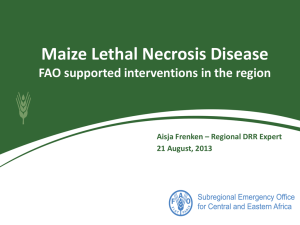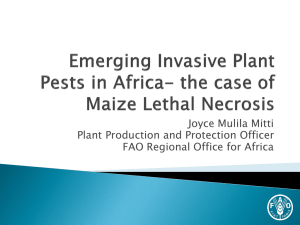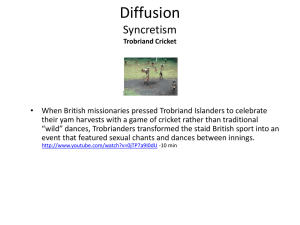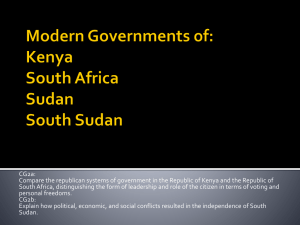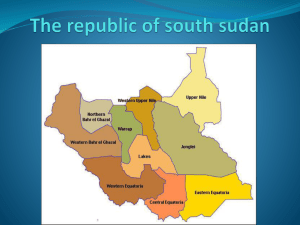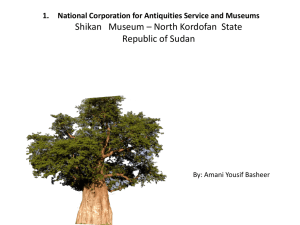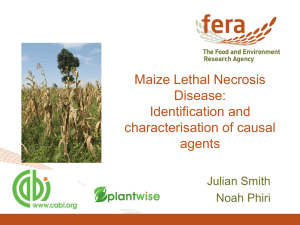FAO and MAFCRD Activities on MLND in South Sudan
advertisement
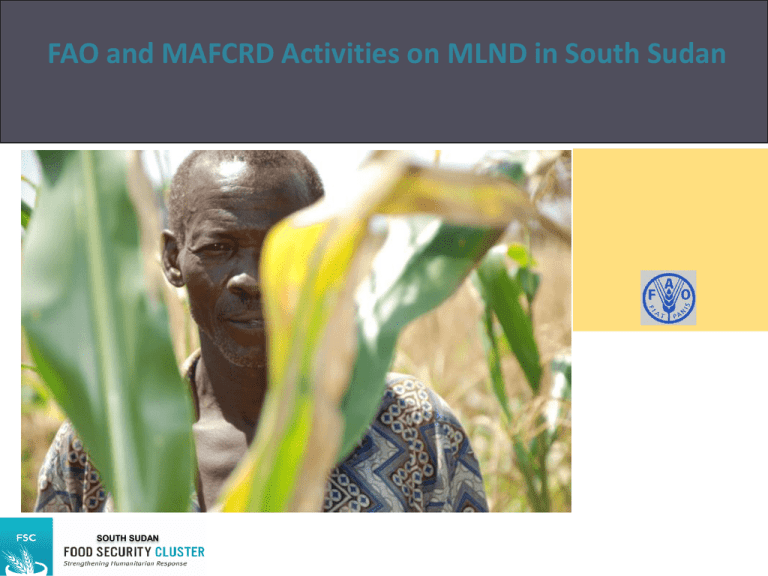
FAO and MAFCRD Activities on MLND in South Sudan Author SOUTH SUDAN Some aspects of FAO activities in South Sudan • • • • • • • FAO is a Food security and livelihoods (FSL) core pipeline manager in South Sudan FAO is mandated to ensure the provision and to contribute to production of quality planting materials and training of stakeholders and beneficiaries in South Sudan in the production of diseased free planting materials FAO developed linkages with reliable and legally recognized seed companies outside South Sudan for supply of seed inputs to its beneficiaries Currently FAO is engaged in supporting local seed multiplication through community based seed multiplication projects in collaboration with the Ministry of Agriculture and Forestry at central and state levels Established a seed laboratory in Yei, Central Equatoria State for testing seed purity, viability and quality for local production, recollection and redistribution to farming communities in the deficit states In this agricultural season FAO significantly reduced the international procurement of seed inputs and increased local production by above 70% of its overall pipeline in the country Soaring prices of food items and dwindling purchasing power of South Sudan households triggered an increased commitment in sustainable agriculture production using own adaptable seeds. FAO and MAFCRD Activities on MLND in South Sudan • • • • • • • • • FAO conducted a first diagnosis survey in East Equatoria State in July 2013 in collaboration with MAFCRD and the State Ministry of Agriculture and Forestry Eastern Equatoria State, in Magwi County Samples of suspected plant parts were collected from Lerwa and Obbo Payams in Magwi County where the severity of associated symptoms of MLND were observed to be prevalent. MLND related symptoms were only observed in the Longe maize varieties and none in the hybrid maize fields in the area surveyed Symptoms on Infected plants observed include (stunting, strip yellowing, dead leaf tips progressing towards the leaf sheath, failed grain filling, deformed tassels, drying of the shoot tips, rotting of the tassels and cobs, one cob established per plant etc. Field distribution of MLND related symptoms are observed to occur in isolation at hot spots but not uniformly manifested in the field Farmers and extension workers lack information on the root causes of abnormality on their maize fields. They culturally uproot affected plants and replant new seeds to reduce further infestations Farmers started observing the occurrence of the abnormal symptoms in the area in 2012 Samples collected have been packed as advised by Julian Smith and will be sent to a UK based agency (Fera) for laboratory diagnosis after issuance of phytosanitary certificate. FAO in collaboration with MAFCRD will build resilience of national and state task forces as well as frontline extension service providers for early warning detection and monitoring, raising awareness to manage the spread of the disease in the Country in collaboration with the regional and international insttitutions. Samples of maize plants suspected to be affected plants in Magwi County Maize plants with suspected symptoms of MLND in Eastern Equatoria State, Magwi County, South Sudan Suspected samples cont’d • A: Maize cob from a plant suspected to be infected by MLND (grown without fertilizers) • B: With fertilizers and the cob is empty Proposal on MLND response and building resilience • • • • • • • • Though prevalence of MLND hasn’t been confirmed in South Sudan yet, there is a high chance of possible entry of diseased planting materials across borders Institutional weaknesses: No rigorous support to protection and control of crop pests and diseases across borders due to lack of deployed planting materials inspectors at border posts Farmers and private sectors mistakenly import diseased or diseased free planting materials into the country due to high demand Though there are numerous challenges on crop protection in South Sudan, high opportunities exist for inhibition of the disease A three year proposal is being developed on building resilience to the threat of MLND in South Sudan This project is expected to contribute to the establishment of an effective network among stakeholders at national and state level to understand and manage the disease spread in the Country Carry out stocktaking of the prevalence and spread of MLND and build the capacity of stakeholders in early warning detection, monitoring the occurrence and the movement of MLND across the borders, Enhancing knowledge on MLND and introduction of good agricultural practices to mitigate the spread in the Country. The need for support from National, regional and International R4D (ASARECA, FAO, IITA, NGOs) • • • • • • • • • • Develop good working relations with national, regional and international organizations to support in the management and control of pests and diseases across borders South Sudan will benefit from research and technologies developed by other countries and international organizations to prevent and control pests and diseases Share lessons learned and best practices in the management and control of crop pests and diseases Commitment of the Government of South Sudan to end food insecurity by 2014 through increased collaborations with partners (e.g. the Zonal Efforts for Agriculture Transformation and National Efforts to Agricultural Transformation, ZEAT/NEAT respectively) South Sudan developed plant protection policy for 2012 – 2017. Though this exist, but they are lack the institutional structure to implement the functions in the country Established a dedicated plant protection department in the Ministry of Agriculture and Forestry for the control and reduction of pests and diseases affecting field crops and storage produce. Established research and extension units for promoting crop varieties which are resistant to major pests and diseases in South Sudan Strengthen coordination with national, regional and international organizations to enhance effective management of pests and diseases MAFCRD has already concluded a proposal to establish a South Sudan Agricultural Research Organization (SSARO) to carry out agricultural research Some trained personnel already are available and await deployment to execute the mandate of SSARO, however lack of infrastructures continue to hamper progress Plans to rehabilitate two agriculture research stations in South Sudan (Yambio and Yei) in addition to the existing basic seed centres in Palotaka (EES) in the Greenbelt corridor and Halima (soil lab) for the Ironstone agro ecological zones respectively) Thank You!
